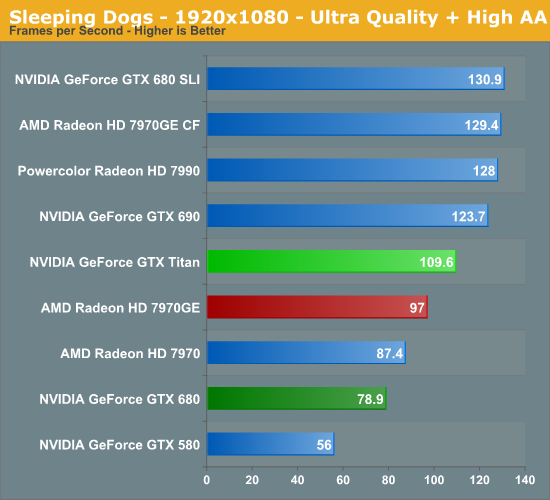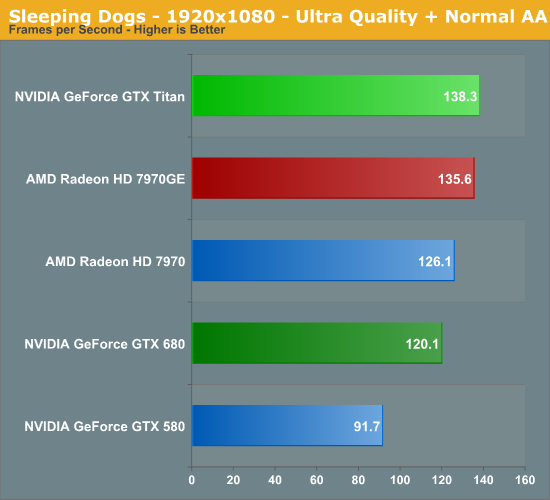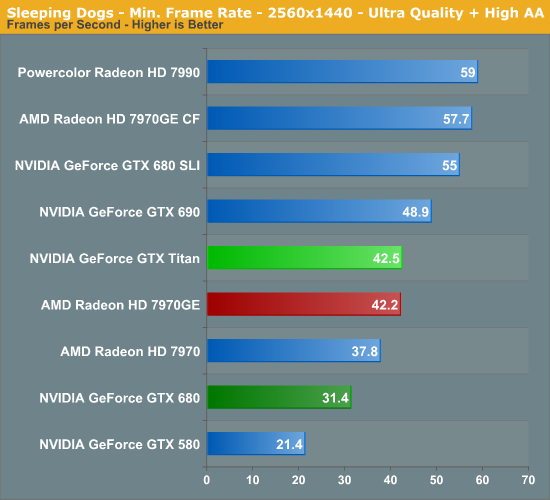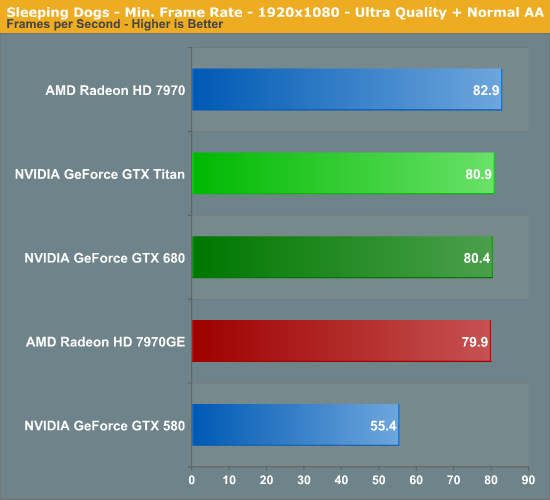NVIDIA’s GeForce GTX Titan Review, Part 2: Titan's Performance Unveiled
by Ryan Smith & Rahul Garg on February 21, 2013 9:00 AM ESTSleeping Dogs
Another Square Enix game, Sleeping Dogs is one of the few open world games to be released with any kind of benchmark, giving us a unique opportunity to benchmark an open world game. Like most console ports, Sleeping Dogs’ base assets are not extremely demanding, but it makes up for it with its interesting anti-aliasing implementation, a mix of FXAA and SSAA that at its highest settings does an impeccable job of removing jaggies. However by effectively rendering the game world multiple times over, it can also require a very powerful video card to drive these high AA modes.




Sleeping Dogs is another game that AMD cards have done rather well at, leaving the GTX 680 quite a way behind. The sheer increase in functional units for Titan means it has no problem vaulting back to the top of the list of single GPU cards, but it also means it’s crossing a sizable gap.
In the end, at 2560 at the High (second-highest) AA settings, Titan is just shy of 50% faster than the GTX 680, but a weaker 17% ahead of the 7970GE. As we drop in resolution/AA, so does Titan’s lead, as the game shifts to being CPU limited.
Notably, no single card is really good enough here for 2560 with Extreme AA, with even Titan only hitting 35fps. This is one of the only games where even with a single monitor there’s real potential for a second Titan card in SLI.
Meanwhile the gap between Titan and our dual-GPU cards is roughly as expected. The GTX 690 takes a smaller lead at 18%, while the 7990 is some 42% ahead.
Due to its built-in benchmark, Sleeping Dogs is also another title that is a good candidate for repeatable and consistent minimum framerate testing.




While on average Titan is faster than the 7970GE, the minimum framerates put Titan in a rough spot. At 2560 with high AA Titan is effectively tied with the 7970GE, and with extreme AA it actually falls behind. It’s not readily apparent why this is, whether it’s some kind of general SSAA bottleneck or if there’s something else going on. But it’s a reminder that at its very worst, Titan can only match the 7970GE.










337 Comments
View All Comments
Veteranv2 - Friday, February 22, 2013 - link
Wow, you base your opinion on 1 game on a point that 1 review site has made without knowing that the FRAPS software measures correctly and that drivers are good with that game?Wow, that blows my mind. How dumb can be people be?
This is the same like saying, wow this 1 musquito didn't give me malaria, malaria doesn't exist....
I am not a fanboy, except for my wallet and honesty.
Anandtech makes a point which it does not prove. That is my point. Hence if you cannot prove a point, but still make it, that makes you subjective. So either prove it, or shut up about it and be objective.
CeriseCogburn - Saturday, February 23, 2013 - link
Yeah it's not one site, this into has been around for years.Just run fraps with your own games vs other frame count methods on both cards idiot.
Oh that's right, you have no experience.
Veteranv2 - Sunday, February 24, 2013 - link
Wow, you are the saddest person I have ever seen on the internet. You seem like you could use a hug or something.Or professional help.
CeriseCogburn - Tuesday, February 26, 2013 - link
Another internet parrot with the usual, repeated a thousand times whenever they have no rebuttal.You fit right in with the rest of the fools.
carlos l - Thursday, February 21, 2013 - link
Titan's most interesting feature is DP performance. The previous gtx 6xx cards have only 1/24 DP, much less than the gtx 5xx. Titan's announced 1/3 DP performance is, in theory, an amazing improvement for gpgpu tasks. It woul be nice if you could ad a benchmark on that feature. I suggest something like GeneferCUDA, an app from Primegrid (a Boinc project) designed for cuda capable cards that uses DP intensively.codedivine - Thursday, February 21, 2013 - link
Look at the DGEMM and FFT (double-precision) benchmarks. Those are both using fp64.chizow - Thursday, February 21, 2013 - link
While the DP performance is great for those that would use it, I think the vast majority of potential buyers would've preferred to see the same neutered DP performance if it meant a more reasonable, historic level of pricing in the $500-$650 range.As a previous owner of these flagship cards, I know I gave 0 fks about the DP performance of the card even though it was respectable relative to the Tesla parts (about half).
alpha754293 - Thursday, February 21, 2013 - link
Does it have the same PCI devID as the Tesla cards?I like how Rahul Garg covered the compute performance using HPC-level code.
Do you or does he know if MATLAB will work with this card?
Thanks.
codedivine - Thursday, February 21, 2013 - link
Rahul here. Not sure about the PCI ID. About MATLAB, while we did not test this, but I see no reason why it will not work with MATLAB.alpha754293 - Thursday, February 21, 2013 - link
Rahul:I loved your analysis. Very useful.
One question question though - nVidia was saying that the single precision peak theorectical floating point rate should be 4.5 TFLOPs. How come your SGEMM only shows 3.something TFLOPS? Is it tuning or optimizations?